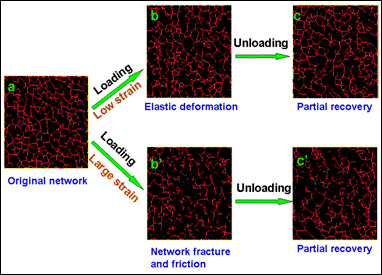Double network structures formed with either two polymer or polymer and inorganic nanofiller have been demonstrated to enhance mechanical properties in orders of magnitude, which is an effective approach to create advanced structural and functional materials with unmatchable properties. The mechanical enhancement is attributed to fracture of network with weak bond while the network with strong bond maintains the integrity of sample. However, as it is still hard to bond fracture directly during loading, especially for inorganic nanofiller network, bond fracture mechanism is still remaining as an empirical or qualitative rule. A team from University of Science and Technology of China (USTC) has gained insight into the NE nature of FIC in polymer material. Their research was published on October 20th, 2015 in Macromolecules.
In this work, we employ in-situ synchrotron radiation X-ray nano-CT carried out at 4W1A-X-ray Imaging station of BSRF to study carbon black filler network embedded in rubber molecular network under cyclic loading. For the first time, destruction and reconstruction of filler network is observed with high spatial resolution (100 nm) in large volume (view field: 60×60 μm2). Based on X-ray image analysis, we obtain network structure parameters such as the size and surface area of filler clusters, mesh size and connectivity of network at different strains. The structural parameters of network reveal that not only network fracture but also elastic deformation of network, and sliding friction between network and rubber matrix contribute to the excellent mechanical property of rubber composites. Combining mechanical data and structural parameters of network, external strain energy is quantitatively assigned to these three mechanisms, respectively. Elastic deformation and friction are major contributors at small strain whilst at large strain network destruction switches to being the largest shareholder. Through orchestra effect of three mechanisms, the overall mechanical enhancement factor of filler network varies in a small range at different strains.

Fig 1: Upon loading carbon black network undergoes elastic deformation, friction and fracture, which partially recovers after unloading. These three structural evolutions of network store and dissipate strain energy, which dramatically enhances the mechanical properties of rubber composites.
Article:
Liang Chen, Weiming Zhou, Jie Lu, Jing Li, Wenhua Zhang, Ningdong Huang, Lihui Wu, Liangbin Li, Unveiling reinforcement and toughening mechanism of filler network in natural rubber with synchrotron radiation X-ray Nano-Computed Tomography, Macromolecules, 2015, 48, 7923-7928.


